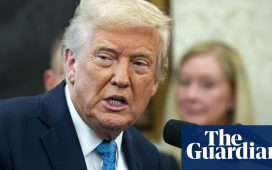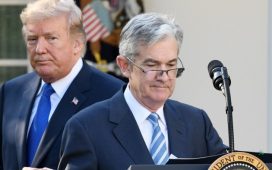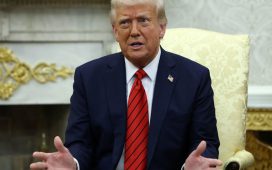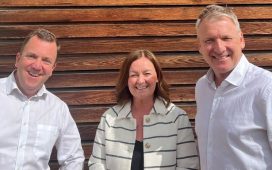Receive free Markets updates
We’ll send you a myFT Daily Digest email rounding up the latest Markets news every morning.
This article is an on-site version of our Unhedged newsletter. Sign up here to get the newsletter sent straight to your inbox every weekday
Good morning. It is nice to see the electric car price wars continue, with Ford cutting the price of its Lightning pick-up (which I want) 10 per cent or so to $50,000. If only we could get New York bars to roll back martini prices, I could forget the last few years of inflation entirely. Email me: robert.armstrong@ft.com.
Potemkin rate increases
A Potemkin village is a facade designed to impress, but without any real substance. A rapid fall in inflation without an accompanying decline in demand has raised the question of whether the Fed has just done 500 basis points of Potemkin rate increases. Rate hikes control inflation by cooling demand, bringing it back into balance with supply. If inflation has fallen sharply without a parallel drop in demand, then perhaps the rate increases were fundamentally performative.
Paul Krugman summed up the case for a Potemkin Fed on Twitter last Friday:
A lot of people saying that disinflation was caused by Fed rate hikes. And even though I supported those hikes — I don’t think there was any alternative — I’m puzzled by these claims. How is this supposed to have worked? The textbook story is that it works like this: Higher rates → economic slack → disinflation. But where’s the rise in economic slack? Do people have a theory of immaculate transmission of monetary policy to prices, without any real-economy weakness along the way? If so, what is that theory? . . . “It was the Fed wot did it” takes look a lot less justified than many are claiming.
It’s not totally clear to me what Krugman means by “I don’t think there was any alternative.” If inflation was going to fall without the rate increases, then the alternative was not doing the rate increases. My guess is he means something like this: if the Fed didn’t raise rates in the face of inflation, everyone might have panicked, risking a sharp increase in inflation expectations and an inflationary spiral. This risk had to be avoided even if, absent such a panic, inflation would have fallen on its own.
My colleague Martin Sandbu, I should note, was banging the drum on this point long before Krugman got in on the act. Back on June 1, for example, he wrote the following, discussing a paper by Ben Bernanke and Olivier Blanchard:
[I’ve argued that] our maximally unfortunate series of inflationary shocks will soon go away by themselves . . . Bernanke and Blanchard find, essentially, that labour markets were the dog that didn’t bark. Labour market tightness only accounts for a sliver (the red segment of their column chart, reproduced below) of inflation above the Federal Reserve’s target of 2 per cent since the end of 2019 . . . take this research, then, to support the view that our current inflationary episode is mostly down to a series of negative supply-side or demand-composition shocks — it is not the consequence of outsize aggregate demand.
James Athey of Abrdn argued in an email that the supply-driven character of the inflation spike was obscured by incessant talk of “sticky” inflation:
It is prices and wages which are sticky, not inflation and wage growth. And so even if prices remain elevated (ie, the price level has moved up) that is unequivocally not the same as inflation remaining elevated . . . Prices are levels, inflation is changes; a key distinction often lost it seems.
What has happened is a series of global supply shocks pushed key input price levels up. Then, with a lag, the wider economy responded to this by raising the prices of other keys goods and services. Those rising prices then led to higher wage demands which, largely because of the pandemic’s effect on global labour markets, were met. Then you get into some of the second-round effects we have seen.
There is, however, a straightforward counterargument to the view that the rate rises were basically for show. It is that the economy has cooled since rate increases began, even if gradually. Consider one most obvious indicator, job creation:

In an email, Bob Michele, chief investment officer at JPMorgan Asset Management, made the case for the importance of the rate increases:
The rise in interest rates has had a material impact on consumer spending which has had an impact on housing and auto sales/prices. Both markets have softened quite a bit as consumers face a significant increase in funding costs to purchase homes or autos. The recently released Manheim used vehicle value index decreased 4.2 per cent . . . the largest drop since April 2020, and it’s at the lowest level since mid-2021. Case-Shiller home prices are also down on a year-over-year basis . . .
Real spending (month-over-month) has been negative or flat 5 out of the last 7 months. The Redbook same-store sales index turned negative in the first week of July for the first time since the pandemic . . . and before that, the Great Financial Crisis. This is hardly an environment where retailers would push up prices.
Paul Ashworth of Capital Economics adds another point. When supplies were constrained, small increases in demand pushed prices up quickly. Now, on the other hand, small decreases in demand kill inflation more or less instantly:
[W]hen the economy is operating close to potential the aggregate supply function is close to vertical — whereas in the environment we were in for the decade before COVID it was close to horizontal, explaining why the Fed couldn’t get inflation up to 2 per cent . . . but in the COVID world . . . small changes in demand suddenly started having massive impacts on prices. But that works in reverse too. If we were/are still at the near-vertical point of the aggregate supply curve, even a small drop back in demand could be expected to generate a big disinflation . . .
So this is not an immaculate disinflation — it’s a lot of disinflation for not much demand destruction
I find these counterarguments pretty sensible and compelling, so I think it is wrong to say that the rate increases have been all for show. Adam Shapiro of the San Francisco Fed divides personal consumption expenditures inflation into demand- and supply-driven components by distinguishing prices that change in the same direction as volumes (demand) and in the opposite direction (supply). On this method, supply has been the bigger contributor to inflation during the Covid-19 episode, but now the balance is roughly even. His chart:

The Fed’s rate increases, as far as I can tell, are only part Potemkin. But I still think I significantly overestimated the importance of demand for inflation, and demand destruction for bringing it down. As a result, I probably overestimated the risk of recession. Just a week or two ago, I put the odds of recession before mid-2024 at 60 per cent. After several days of hard reflection, I would now put the odds somewhere between 40 per cent and 50 per cent.
Why keep my odds of recession even that high, given the current combination of strong demand and falling inflation? Two things. One, the smaller, demand-driven component of inflation may take longer to bring down than the larger supply-driven component, forcing the Fed to keep rates high until the economy sustains real damage. Matt Klein recently argued that, as consumer spending tracks wages closely and nominal wages are running at about 5 per cent,
real volumes of goods and services would have to rise about 3-4 per cent a year for the current pace of wage increases to be consistent with 2 per cent inflation. That would certainly be my preference, and there are good reasons to think that productivity might accelerate, but the likelier outcome is that underlying inflation is closer to 4 per cent than 2 per cent . . . At this point, the hope is that the current bout of disinflation buys time for wage growth to (somehow) slow down on its own without the need for any active measures to hurt the economy
Second, there is the worry that the rate increases already completed are enough to damage the economy, but are just taking their time doing it. As Athey puts it:
The data right now is really suggestive of a soft landing, but therein lies the problem. Today’s data tells us more about fed policy 12 months ago than it does today. Roll the clock forwards and things don’t look so rosy!
One good read
Good marriages and joint checking accounts.
FT Unhedged podcast

Can’t get enough of Unhedged? Listen to our new podcast, hosted by Ethan Wu and Katie Martin, for a 15-minute dive into the latest markets news and financial headlines, twice a week. Catch up on past editions of the newsletter here.









